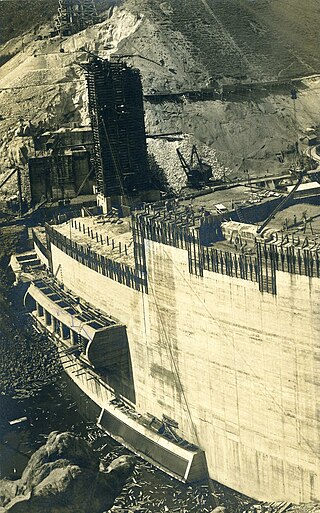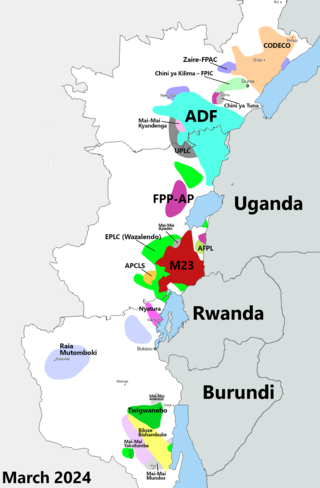Related Research Articles
The earliest known human settlements in what is now the Democratic Republic of the Congo have been dated back to the Middle Stone Age, approximately 90,000 years ago. The first real states, such as the Kongo, the Lunda, the Luba and Kuba, appeared south of the equatorial forest on the savannah from the 14th century onwards.
The Armed Forces of the Democratic Republic of the Congo is the state organisation responsible for defending the Democratic Republic of the Congo. The FARDC was rebuilt patchily as part of the peace process which followed the end of the Second Congo War in July 2003.

The Democratic Republic of the Congo is a country in Central Africa. By land area, the DRC is the second-largest country in Africa and the 11th-largest in the world. With a population of around 112 million, the Democratic Republic of the Congo is the most populous Francophone country in the world. The national capital and largest city is Kinshasa, which is also the economic center. The country is bordered by the Republic of the Congo, Central African Republic, South Sudan, Uganda, Rwanda, Burundi, Tanzania, Zambia, Angola, the Cabinda exclave of Angola, and the South Atlantic Ocean.

North Kivu is a province bordering Lake Kivu in the eastern Democratic Republic of the Congo. Its capital is Goma. The 2020 population was estimated to be 8,147,400.

South Kivu is one of 26 provinces of the Democratic Republic of the Congo (DRC). Its capital is Bukavu.

Bukavu is a city in eastern Democratic Republic of the Congo (DRC), lying at the extreme south-western edge of Lake Kivu, west of Cyangugu in Rwanda, and separated from it by the outlet of the Ruzizi River. It is the capital of the South Kivu Province and as of 2012 it had an estimated population of 806,940.

Kivu was the name for a large "region" in the Democratic Republic of the Congo under the rule of Mobutu Sese Seko that bordered Lake Kivu. It included three "Sub-Regions" : Nord-Kivu, Sud-Kivu and Maniema, corresponding to the three current provinces created in 1986. The capital of the Kivu Region was in Bukavu, and the capitals of the three Sub-Regions were in Goma, Uvira and Kindu.
Banyamulenge is a community from the Democratic Republic of the Congo's South Kivu province. The Banyamulenge are culturally and socially distinct from the Tutsi of North Kivu, with most speaking Kinyamulenge, a mix of Kinyarwanda, Kirundi, Ha language, and Swahili. Banyamulenge are often discriminated against in the DRC due to their Tutsi phenotype, similar to that of people living in the Horn of Africa, their insubordination towards colonial rule, their role in Mobutu's war against and victory over the Simba Rebellion, which was supported by the majority of other tribes in South Kivu, their role during the First Congo War and subsequent regional conflicts (Rally for Congolese Democracy–Goma, Movement for the Liberation of the Congo, National Congress for the Defence of the People, and more importantly for the fact that two of the most influential presidents of their country declared them as enemy of the State both in 1996 and 1998.

The First Congo War (1996–1997), also nicknamed Africa's First World War, was a civil war and international military conflict which took place mostly in Zaire, with major spillovers into Sudan and Uganda. The conflict culminated in a foreign invasion that replaced Zairean president Mobutu Sese Seko with the rebel leader Laurent-Désiré Kabila. Kabila's unstable government subsequently came into conflict with his allies, setting the stage for the Second Congo War in 1998–2003.

Rutshuru is a town located in the North Kivu province of the eastern Democratic Republic of the Congo, and is headquarters of an administrative district, the Rutshuru Territory. The town lies in the western branch of the Albertine Rift between Lakes Edward and Kivu. The Ugandan border is 15 km east and the Rwandan border is 30 km south-east. Lava flows from the Nyamuragira volcano, 40 km south-west, have come within 7 km of the town in recent years.

Masisi Territory is a territory which is located within the North Kivu Province of the Democratic Republic of the Congo. Its political headquarters are located in the town of Masisi.

The Kivu conflict is an umbrella term for a series of protracted armed conflicts in the North Kivu and South Kivu provinces in the eastern Democratic Republic of the Congo which have occurred since the end of the Second Congo War. Including neighboring Ituri province, there are more than 120 different armed groups active in the eastern Democratic Republic of Congo. Currently, some of the most active rebel groups include the Allied Democratic Forces, the Cooperative for the Development of the Congo, the March 23 Movement, and many local Mai Mai militias. In addition to rebel groups and the governmental FARDC troops, a number of national and international organizations have intervened militarily in the conflict, including the United Nations force known as MONUSCO, and an East African Community regional force.

The Simba rebellion, also known as the Orientale revolt, was a regional uprising which took place in the Democratic Republic of the Congo between 1963 and 1965 in the wider context of the Congo Crisis and the Cold War. The rebellion, located in the east of the country, was led by the followers of Patrice Lumumba, who had been ousted from power in 1960 by Joseph Kasa-Vubu and Joseph-Désiré Mobutu and subsequently killed in January 1961 in Katanga. The rebellion was contemporaneous with the Kwilu rebellion led by fellow Lumumbist Pierre Mulele in central Congo.
The Congolese Rally for Democracy, also known as the Rally for Congolese Democracy, is a political party and a former rebel group that operated in the eastern region of the Democratic Republic of the Congo (DRC). It was supported by the government of Rwanda, and was a major armed faction in the Second Congo War (1998-2003). It became a social liberal political party in 2003.
The following is a timeline of the history of the city of Goma, Democratic Republic of the Congo.
The Kanyarwanda War was a conflict in the northeastern region of Congo-Léopoldville, specifically the newly-established province of North Kivu, between the Banyarwanda and indigenous groups within North Kivu including the Hunde and Nande groups that lasted from 1963 to 1966. It was sparked by years of ethnic tensions between the Banyarwandan people, who had significant influence and power in North Kivu and surrounding provinces, and native groups such as the Hunde and Nande groups.
Justin-Prudent-François-Marie Malfeyt was a Belgian soldier, engineer and administrator. He served in various senior administrative positions in the Belgian Congo, including command of the Orientale and Katanga provinces.

Kivu Province was a province in the Belgian Congo, originally called Costermansville Province, that was formed in 1933 from part of the old Orientale Province. The Republic of the Congo (Léopoldville) became independent in 1960, and between 1962 and 1966 the province was temporarily broken into the provinces of Maniema, North Kivu and South Kivu. In 1988 it was again broken into these provinces.

Frederik-Valdemar Olsen was a Danish soldier who became a general and commander in chief of the Belgian Congo Force Publique. He was born into a poor family, joined the Danish army, then in 1898 volunteered to serve in the Congo Free State. He rose quickly through the ranks, and in 1909–1910 played an important role in a stand-off with German and British forces disputing the eastern border of what was now the Belgian Congo. During World War I Olsen commanded a force that defended Northern Rhodesia against a German attack, then advanced from the south of Lake Kivu to take Tabora in what is now Tanzania. After the war he became commander of the Force Publique before retiring as a general in 1925. Olsen was then made general manager of the state-owned Congo River shipping line Unatra, later combined with railway lines to form Otraco. He retired from this position in 1947.

The Kivu frontier incident was a 1909–1910 stand-off between Belgian, British and German forces in the region around Lake Kivu, now divided between the Democratic Republic of the Congo, Uganda and Rwanda. War was averted through diplomatic negotiations, and it was agreed that the western and northwestern part of the region came within the jurisdiction of the Belgian Congo, while the eastern part was divided between the British Uganda Protectorate to the northeast and the Rwanda district of German East Africa to the southeast.
References
- ↑ Stearns, Jason (2012). "North Kivu: The background to conflict in north Kivu province in eastern Congo" (PDF). refworld.org. p. 14.
- ↑ Williams, Susan (2016-08-09). "Chapter 12 - The Cutout". Spies in the Congo: America's Atomic Mission in World War II. PublicAffairs. ISBN 978-1-61039-655-4.